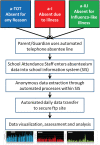The Oregon Child Absenteeism Due to Respiratory Disease Study (ORCHARDS): Rationale, objectives, and design
- PMID: 34623760
- PMCID: PMC8818813
- DOI: 10.1111/irv.12920
The Oregon Child Absenteeism Due to Respiratory Disease Study (ORCHARDS): Rationale, objectives, and design
Abstract
Background: Influenza viruses pose significant disease burdens through seasonal outbreaks and unpredictable pandemics. Existing surveillance programs rely heavily on reporting of medically attended influenza (MAI). Continuously monitoring cause-specific school absenteeism may identify local acceleration of seasonal influenza activity. The Oregon Child Absenteeism Due to Respiratory Disease Study (ORCHARDS; Oregon, WI) implements daily school-based monitoring of influenza-like illness-specific student absenteeism (a-ILI) in kindergarten through Grade 12 schools and assesses this approach for early detection of accelerated influenza and other respiratory pathogen transmission in schools and surrounding communities.
Methods: Starting in September 2014, ORCHARDS combines automated reporting of daily absenteeism within six schools and home visits to school children with acute respiratory infection (ARI). Demographic, epidemiological, and symptom data are collected along with respiratory specimens. Specimens are tested for influenza and other respiratory viruses. Household members can opt into a supplementary household transmission study. Community comparisons are possible using a pre-existing and highly effective influenza surveillance program, based on MAI at five family medicine clinics in the same geographical area.
Results: Over the first 5 years, a-ILI occurred on 6634 (0.20%) of 3,260,461 student school days. Viral pathogens were detected in 64.5% of 1728 children with ARI who received a home visit. Influenza was the most commonly detected virus, noted in 23.3% of ill students.
Conclusion: ORCHARDS uses a community-based design to detect influenza trends over multiple seasons and to evaluate the utility of absenteeism for early detection of accelerated influenza and other respiratory pathogen transmission in schools and surrounding communities.
Keywords: absenteeism; children; influenza; population surveillance; school.
© 2021 The Authors. Influenza and Other Respiratory Viruses published by John Wiley & Sons Ltd.
Figures



References
-
- CDC . Disease burden of influenza. https://www.cdc.gov/flu/about/burden/index.html. Accessed 6/22/2020.
Publication types
MeSH terms
Grants and funding
LinkOut - more resources
Full Text Sources
Medical

